The traditional role of food packaging is changing in response to market needs. Among these are current needs and drivers such as consumer demand for safer, healthier and higher quality foods, ideally with a long shelf life. The demand for convenient and transparent packaging and the preference for more sustainable packaging materials have led to the development of new packaging technologies, such as active packaging (AP).
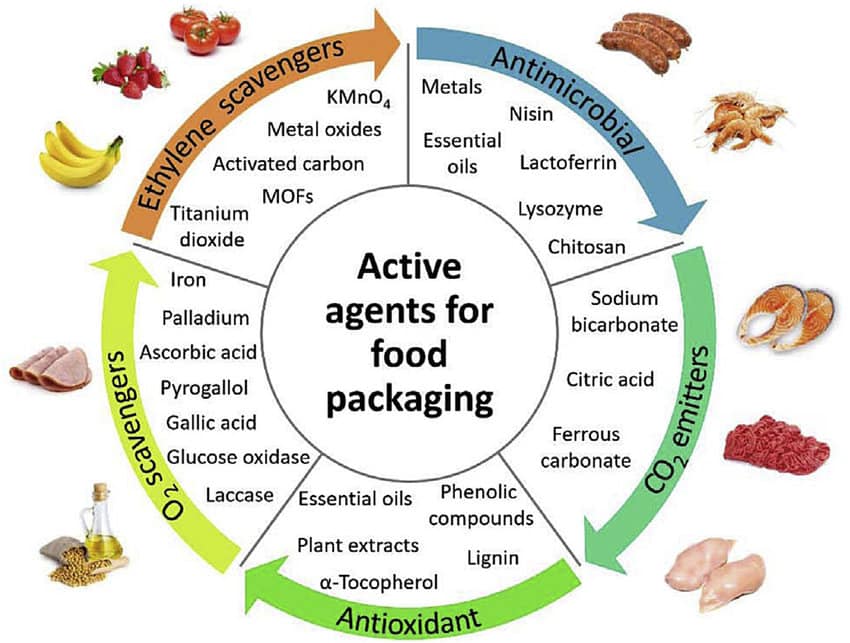
Active packaging and its types in the last 25 years
Active modified packaging has been used in the past 25 years, especially in America and Japan, to preserve food, and the use of various types of this type of packaging is expanding day by day.
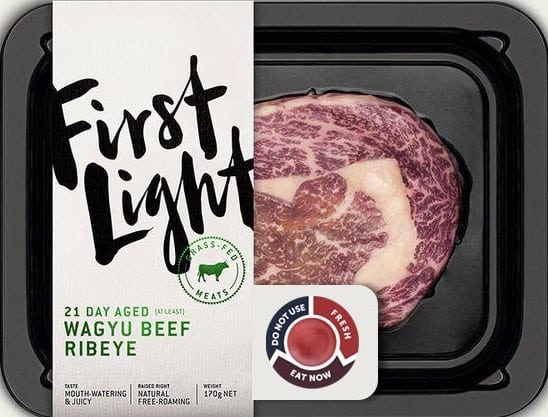
This type of package has been produced in different types, such as the types that have additives to preserve the freshness of the product, which can have multiple applications and are effective in preserving food in comparison with the old packaging.
Active substances or agents are directly or indirectly in contact with food. Active ingredients include oxygen absorbers, carbon dioxide, moisture, ethylene, ethanol releasing agents, flavoring agents and antimicrobial agents.
Types with the ability to change physical characteristics, such as (self-heating/cooling) packages, are also considered active packages. Active packaging is used for various types of food such as bread, cake, dessert, pizza, fresh dough, cheese, meat and its products, and fruits.
Definition of active packaging based on (EC)
As defined in European Regulation (EC) No. 450/2009, active packaging systems are designed to intentionally incorporate components that allow materials to be incorporated into or removed from the packaged food or release or absorb food from the surrounding environment. Active packaging materials are packaged in this way in order to increase shelf life or preserve or improve the condition of food.
What will we talk about in this article?
Although extensive research is being done on active packaging technologies, many of these technologies have yet to be successfully applied in food packaging systems, for several reasons such as: Accuracy and precision of performance, price, industrial design and unnatural and chemical materials have not been implemented.
Of course, broad communication of their benefits in food product applications will facilitate successful development and commercialization. In this review by the team of Vira An overview of active packaging technologies, such as antimicrobial, antioxidant, or carbon dioxide-releasing systems, and oxygen, moisture, or ethylene absorbing systems, will be provided and we will discuss its types in the next articles.
In addition, the challenges in using active packaging technologies in food systems and the anticipated direction of future developments are discussed. This review provides the food and packaging industry with a thorough understanding of the benefits of active packaging technologies when applied to specific foods and can therefore help accelerate commercial adoption.
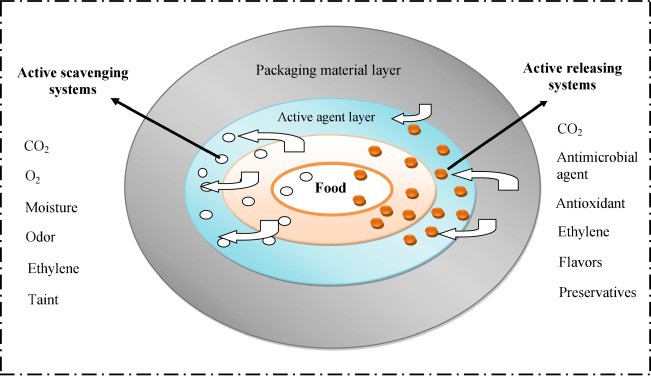
What are the main reasons for the loss of food quality?
Excess water, oxidation and microbial growth (such as pathogenic microorganisms including bacteria and fungi) are the main causes of loss of food quality and safety during production, processing, transportation and storage, as they significantly degrade food quality and shelf life of products increase the risk of food-borne diseases.

Therefore, excess water in food packaging is a major global concern. To increase the stability of food, maintain the main organoleptic properties of food, maintain food safety, reduce waste and minimize the risk of food-borne diseases, the food industry is forced to develop new ways to reduce the effects of oxidation, microbial spoilage has affected food quality (including safety) and economic losses.
As a result of these efforts, active packaging has emerged as a new and promising technology in the field of food packaging to meet the demands of modern society and consumers. It is also a popular topic for researchers around the world.
The role of active packaging in food packaging
Active food packaging is designed to enhance favorable interactions with the packaged food by incorporating active ingredients intended to be released into the food or absorbed into or from the packaged food or the environment surrounding the food (European Commission , 2004, 2009).
The substances responsible for the active function of the packaging (active ingredients) can be directly in the packaging material or on its surface, in multilayer structures or in specific elements related to the packaging such as sachets (a small disposable bag that usually contains consumables such as sauce , powder, shampoo, medicine, etc. Sachet is used in food, health, pharmaceutical and similar industries), self-adhesive.
Food packaging laws
Labels or bottle caps, according to EU food contact material(FCM) legislation (such as Regulations 1935/2004/EC and 450/2009/EC) (European Commission, 2004, 2009), active ingredients must not mislead the consumer. (such as covering spoiled food), and must be adequately labeled using the words “DO NOT EAT” or a symbol to prevent the non-edible part from being confused with a food part (such as loose-leaf sachets) and likewise, they should not have direct contact with the internal environment of the packaging, because from the point of view of the World Health Organization, this connection is somehow considered external contamination and will have the possibility of contaminating the food inside the package.
Before active ingredients can be used commercially, they must be approved by the US FDA or EC based on evaluation and tests such as migration testing, which includes general migration tests and specific migration tests, and sometimes specific tests.
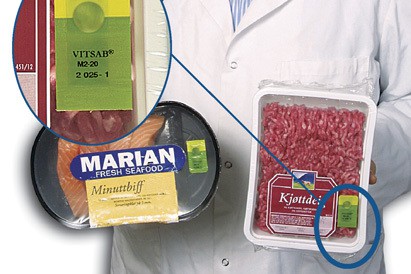
Classification of AP types
For semi-solid food, active packaging can be classified into two main types: Active inhibitor packaging (such as moisture absorbent, carbon dioxide absorbent/absorbent and antioxidant packaging) and active release packaging (such as carbon dioxide producing packaging and antimicrobial packaging).
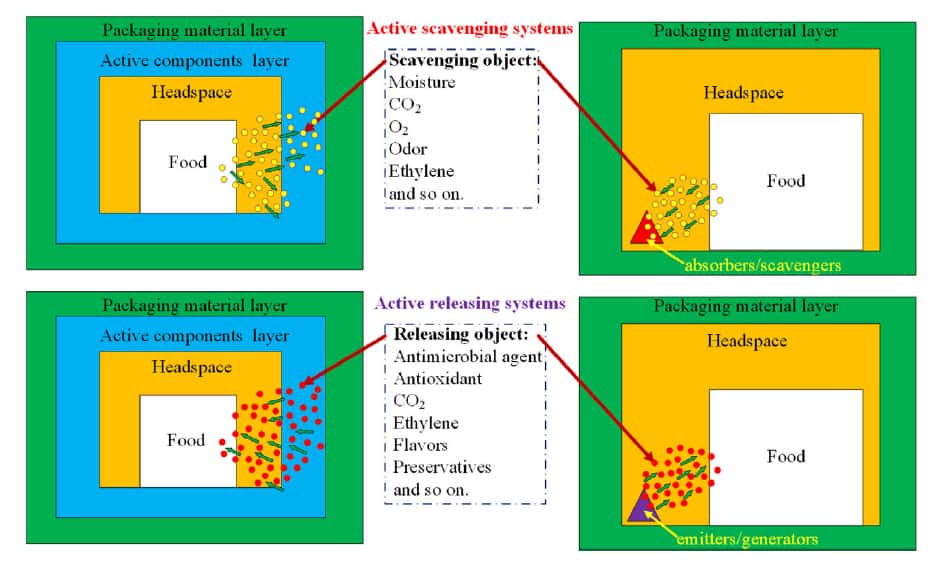
Moisture absorbers are the most well-known examples of active inhibitor packaging
Desiccants are the most well-known examples of active barrier packing and mainly involve absorbing water by incorporating absorbent materials (such as silica gel, molecular sieves, calcium oxide, and natural clays) in a bag for use with packaging, tray-format drip absorption pads (coated and modified atmosphere), consisting of a superabsorbent polymer sandwiched between two layers of microporous or nonwoven polymer.
They are the most common moisture absorbents used in fresh meat products. The default polymers used for this purpose are polyacrylate salts and starch graft copolymers.
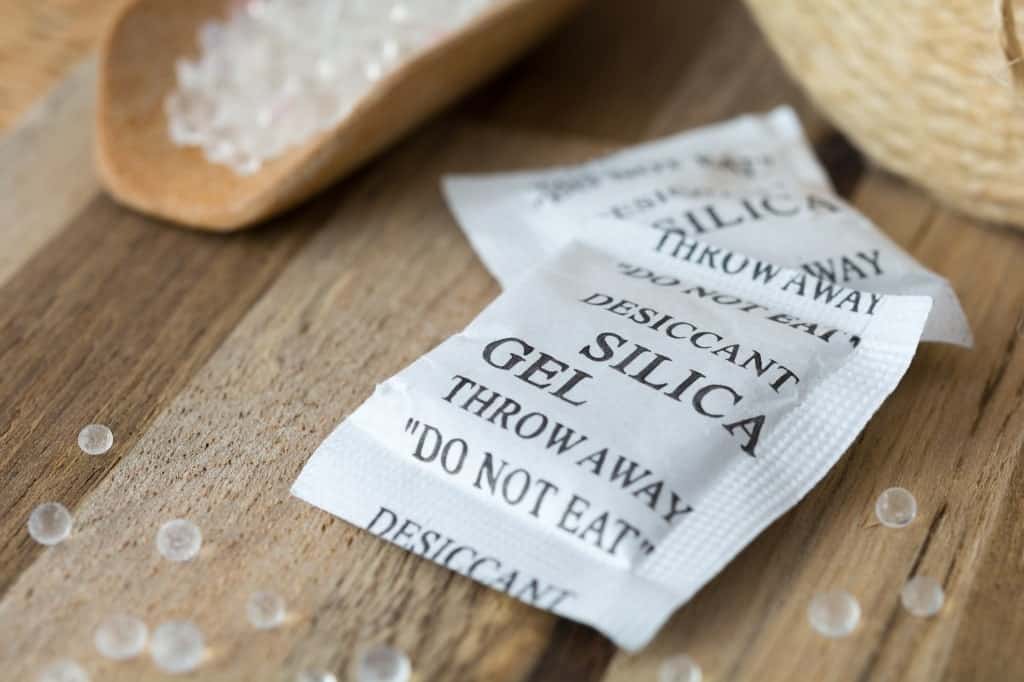
Desiccants are an effective way to control the accumulation of excess water inside food packages with high water content (such as meat, fish, poultry, and fresh produce), which is important for inhibiting bacterial growth, inhibiting mold growth, and strengthening it.
To make the active system invisible and prevent accidental ingestion by the consumer, moisture absorbents are usually incorporated into packaging materials as absorbent pads or trays for meat and fish packaging.
Summary of types of active packaging
The final motive for the development of any new technology is the cost factor. The economic efficiency of smart and active equipment depends on the benefits obtained from such systems. Economic studies show that the cost of many active packaging equipment (absorbers and dispersants) or Smart packaging Like oxygen sensors, it is not and will not be a deterrent factor in commercial scale production, although the little information available in relation to the consumer’s view of such packaging indicates a positive outlook.
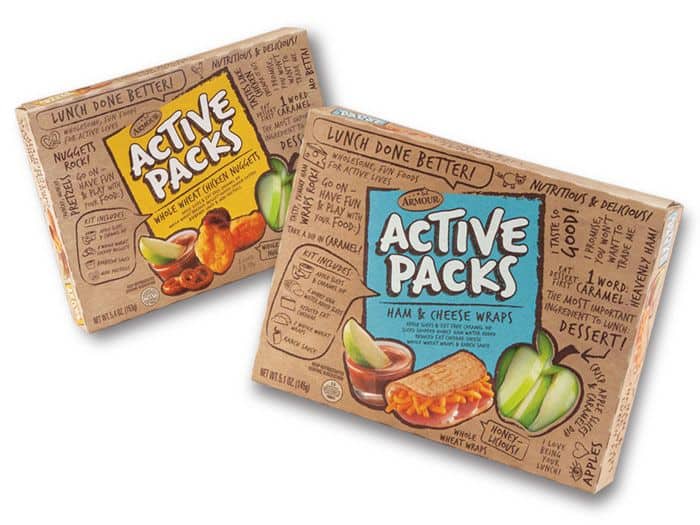
The changes created in the desire of the consumer have led to innovation and development in the field of new packaging. For this reason, anti-microbial packaging is of special interest to researchers and industries, especially food industries, due to its ability to ensure quality and safety. This type of packaging has eliminated the consumer’s need for a product with minimal additives.
In order to better understand the relationship between sensory quality and detection of spoilage, the effective inclusion of sensors in packaging processes on a large scale, the need to be aware of the performance of intelligent packaging in all stages of storage, distribution chain, the problems related to the sensitivity are more than the size and degree of certainty, which provide the background for future investigations.
It is also necessary to point out that although antimicrobial packaging has an effective role in reducing the risk of contamination by pathogenic bacteria and increasing the shelf life of food, it is never a substitute for using high quality raw materials, appropriate processing and using good production methods.
In fact, it is a type of (hurdle technology) that can be used as a complementary method along with non-thermal processing methods such as light pulse, hydrostatic pressure or radiation.
But in the case of self-heating and self-cooling cans, compared to the existing cans, they are more expensive, and for this reason, they are used on a limited level, and it is necessary to conduct more studies in order to find efficient production methods.

